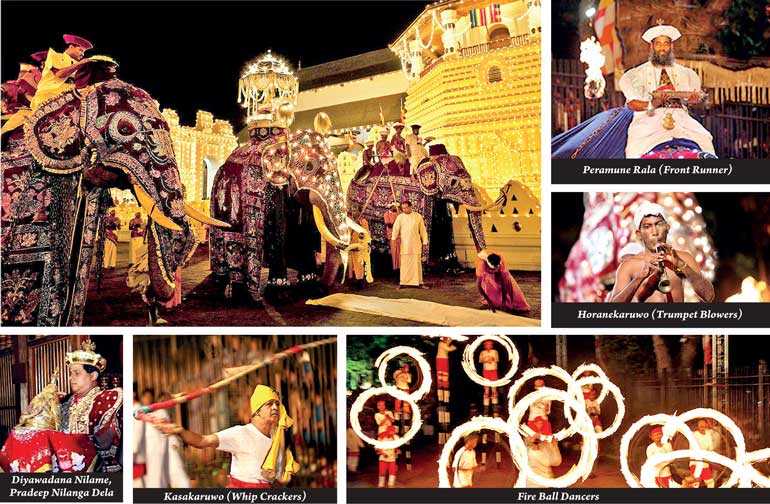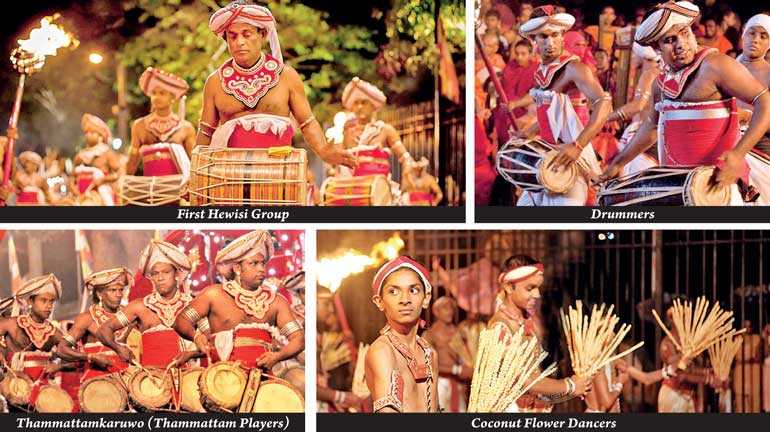Wednesday Mar 19, 2025
Wednesday Mar 19, 2025
Saturday, 18 August 2018 00:10 - - {{hitsCtrl.values.hits}}

By D.C. Ranatunga
It’s past 6 in the evening. The sound of a gunshot is heard from the Dalada Maligawa at the auspicious time. It’s soon followed by the second, third and fourth. Each one is a signal for the devales – Natha, Vishnu, Kataragama and Pattini, in that order – to start their processions.
At the Maligawa the Relic Casket (not the one with the Tooth Relic but another casket with relics) is formally handed over to the Diyawadana Nilame who places it on the tusker assigned to carry the casket. As the devale processions approach the Maligawa, the final shot is heard. It signals the start of the Maligawa Perahera. Crowds who had thronged to the lakeside and either sides of the Perahera route from early hours of the day are excited. ‘Sadhu,’ Sadhu’ they chant.
This will be the routine from Tuesday, 21 August when the Randoli Perahera, the most glamorous of the Kandy Esala Perahera, takes to the streets for five days.
Meanwhile, the Nedungamuve Eth Raja – the tusker who has been fortunate to carry the Relic Casket for the past 12 years – stepped out of his home at Nedungamuwa close to Gampaha last Tuesday amidst the chanting of ‘seth pirith’ by the Maha Sangha to proceed to Kandy. He marches under Army escort – the world’s only elephant to have that privilege.
In and around the Maligawa is a hive of activity getting ready for the big event.
The ‘kasa karuwo’ – whip crackers – have to make sure that the whips, each around seven feet long and made with dried hemp strings, are ready for the task. The handle of the whip is made using rope or any other material which is easy to grip. It was customary in the days of the ancient kings to let the whip crackers get on to the road when the king was going out of the palace and let the people know, thereby paving the way for the king to proceed.
Another reason for the use of whip crackers is to indicate thundering. This is connected with the belief that there would be rain when the Tooth Relic is taken out of the Maligawa.
Many other tasks related to the Perahera are allocated to the Maligawa staff so that everything happens smoothly.
As the Perahera is about to start, the whip crackers get on to the streets and the noise they create indicates the Perahera is on its way.
The Buddhist flag is carried in numbers, thereby establishing that it is a Buddhist festival and a single National flag that is carried symbolises that the Perahera is a national event.
The flags representing different ‘dissawes’ (provinces in the Kandyan era) are carried next. The Hatara Korale flag depicting the sun and the moon is followed by flags of the Hath Korale (lion flag), Uva (swan), Matale (white flag), Sabaragamuwa (yellow flag), Thun Korale (dual-headed eagle), Walapane (peacock), Uda Palata (lotus), Nuwara Kalaviya (elephant), Wellassa (lion), Bintenna (parrot) and Tamankaduwa (bear).

While these 12 flags were used by the Dissawes during the Kandyan Period, there were nine others for areas administered by officials designated as ‘Rate Rala’. These were: Udunuwara, Hewaheta, Yatinuwara, Kotmale, Tumpane, Uda Bulathgama, Harispattuwa, Patha Bulathgama and Dumbara.
In addition to the cloth flags, brass flags are also taken in the Perahera. All these add lot of colour.
Swords are carried next as a symbol of the king’s army which protected the country.
Riding the first elephant in the Perahera is the Peramune Rala – the Maligawa official in charge of documents. These relating to official records, the Maligawa properties and details of the Perahera route are carried in a silver casket.
After the first Hewisi troupe, comes the Gajanayaka Nilame in charge of the tuskers. The goad he carries symbolises his authority.
Various dance troupes follow but since the Diyawadana Nilame has decided that hereafter only traditional Kandyan will be permitted to take part, others may not be given a place. Judging from the wide range of drummers and dancers following Kandyan tradition, there won’t be any lack of performances.
The ‘Kariya Karawana Korala’ gets a place in the Perahera because of the responsibilities he holds.
The varied Kandyan musical instruments are so pleasant to hear and the musicians often combine the music with dancing movements.
The arrival of the tusker carrying the Relic Casket is eagerly awaited. As the tusker marches majestically under ‘udu viyan’ (canopy) walking over the ‘paavada’ (white cloth spread on the route), two other tuskers accompany on either side with riders showering flowers towards the casket.
While the ‘Kavikara Maduwa’ – group of singers – sing paying homage to the Tooth Relic, the Diyawadana Nilame as the lay custodian of the Relic, clad in his colourful traditional garb walks slowly under a ‘muthu kudaya’. The present Diyawadana Nilame, Pradeep Nilanga Dela, is the 19th holding the prestigious post since 1814.
On either side are guards following the tradition of the king’s bodyguards protecting him. Walking behind him are ‘Gam Dahaye Vidanes’ – headmen of 10 villages – again in keeping with an old practice.
That ends the Maligawa Perahera. The four Devale Peraheras then follow.

The name ‘Randoli’ has derived from a custom when the chief queen of the king participated in the Perahera in a palanquin. This practice was later stopped when it was decided that it was not proper for the queen to participate in the Perahera. Instead a palanquin is carried as a symbol.
After five nights of the Randoli Perahera ending on the Nikin Poya day falling on Saturday, 25 August, the Esala pageant ends with the Day Perahera on the following day. This follows the ‘Diya kepeeme mangallaya’ – water-cutting ceremony – at Getambe in the flowing Mahaweli waters.
Pix courtesy
http://sridaladamaligawa.lk
Discover Kapruka, the leading online shopping platform in Sri Lanka, where you can conveniently send Gifts and Flowers to your loved ones for any event including Valentine ’s Day. Explore a wide range of popular Shopping Categories on Kapruka, including Toys, Groceries, Electronics, Birthday Cakes, Fruits, Chocolates, Flower Bouquets, Clothing, Watches, Lingerie, Gift Sets and Jewellery. Also if you’re interested in selling with Kapruka, Partner Central by Kapruka is the best solution to start with. Moreover, through Kapruka Global Shop, you can also enjoy the convenience of purchasing products from renowned platforms like Amazon and eBay and have them delivered to Sri Lanka.
Discover Kapruka, the leading online shopping platform in Sri Lanka, where you can conveniently send Gifts and Flowers to your loved ones for any event including Valentine ’s Day. Explore a wide range of popular Shopping Categories on Kapruka, including Toys, Groceries, Electronics, Birthday Cakes, Fruits, Chocolates, Flower Bouquets, Clothing, Watches, Lingerie, Gift Sets and Jewellery. Also if you’re interested in selling with Kapruka, Partner Central by Kapruka is the best solution to start with. Moreover, through Kapruka Global Shop, you can also enjoy the convenience of purchasing products from renowned platforms like Amazon and eBay and have them delivered to Sri Lanka.